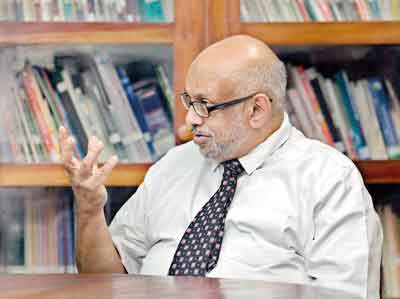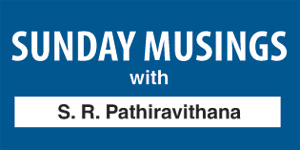Perils of being promiscuous with dangerous drugs
View(s):
Dr. Seevali Jayawickrema stressing a point - Pic by Sameera Weerasekara
Can you remember Asterix and Obilix and the magic portion that made them so invincible? So much so according to the good book, once they even made a clean sweep at the Olympics, with the help of their portion aided physical status. Please do not get too serious, those events were supposed to have happened in 50BC and at that time the World Anti Doping Agency (WADA) was not even thought of.
Ironically, performance enhancing substances still prevail and still they are being used by the younger generation worldwide to perform like Obilix and look like Asterix of yore.
In reality, it is a real problem and one man who is combating this menace is Dr .Seevali Jayawickrema – the Director General of the Sri Lanka Anti-Doping Agency (SLADA). This time, the good doctor and the Musings took time off to discuss the problem and ascertain how it has impacted the younger generation of athletes and those youngsters who have an eye to be body beautiful.
Dr. Jayawickrema initially took time to explain what SLADA does. He said, “The Sri Lanka Anti-Doping Agency (SLADA) was set up by the Ministry of Sports in November 2013 through Act of Parliament; The Convention against Doping in Sports, a convention under UNESCO, was ratified and the local anti-doping body is run by a board headed by Prof. Arjuna de Silva.”
The Convention against Doping in Sports Act 33/ 13 was passed by the Parliament and its objectives were: Measures as required to eradicate doping in sports, to promote research in the area of doping in relation to sports and conduct reciprocal testing between the agency and other International Organisations carrying out similar functions.
SLADA’s motto once again is ‘zero tolerance’, the Director General said.
Explaining the history of doping, Dr. Jayawickrema said the first time it came into focus in the 1920s. But in 1961, a cyclist collapsed while taking part in the Olympics and passed away and at his postmortem, they found that he had been under the influence of an excessive dose of stimulants.
Thereafter, a Medical Commission was established by the International Olympic Committee and this example was followed by FIFA and the World Cycling Authorities.
Dr. Jayawickrema said that doping really came into the limelight with the Ben Johnson saga. At the Seoul Olympics in 1988, all expected Carl Lewis to win the fourth sprint gold to beat Jesse Owens’ record; but, unexpectedly Ben Johnson won with a huge lead. But, Dr. Jayawickrema added that the euphoria was short-lived. In the afterglow of his victory, he was subjected to doping tests and was found positive.
“Since then sports have become more professional. There is a lot of money that is circulated in the arena. Then at times, these athletes also seek short cuts to glory. Though the Olympics is an amateur event, there are Grand Prix events that are being conducted right through the year and there is money there. However, sports in general talks about huge dollars. So to survive in this competitive environment, at times sportsmen/women seek shortcuts.”
Then Musings asked him about the Lankan situation. The Director General explained: “In 1991, at the SAF Games, which was held at the Sugathadasa Stadium in Sri Lanka, we did some tests for the first time. At that time dope testing was not so intense, though most athletes performed at international level. When Sri Lanka became the World Champions in Cricket, the focus was shifted to cricket. Since then we do these tests at random and we find that there are certain sports which are more susceptible to doping than others. Frequently, people come out and inform us about the usage of these substances. So much so since around 2000, we have had about 65 such positive detections.”
What about the schools and the problem there, we asked. The SLADA DG explained that especially in schools’ rugby, there are millions of rupees that are spent on supplements, to maintain the levels of competitiveness.
“Nutrition is an essential part in one’s performance. Whatever the food that you take you use it as energy. To gain speed, power, strength, agility, flexibility — all the components needed to be competitive – so nutrition is the key.
“Frequently, we make very little use of sports professionals like sports nutritionists. They have the ability to assess nutrition that an athlete needs. Then, according to the assessment, they can have a dietary schedule which can be given to the parents saying that this is the diet that your son or daughter needs to enhance their performance.”
He said that then they could assess if they are in need of any additional nutrients. “We know the main three fuels – carbohydrates, proteins and fat. Carbohydrate is the main source that we burn as energy when we are engaged in sports. Protein will support with the strengthening part, because all the muscle tissues are made of proteins. For that we need an adequate amount of proteins – age wise and height wise – we have to calculate with the weight. Also, we have to consider the body-fat content. Extra fat should be reduced through exercise and then if you want to maintain that weight you have to supplement it with proteins, to get the muscle tone instead of the fat content.”
He said that very often they find that athletes using substances, instead of natural food to replace their proteins. “Now a lot of nutraceuticals and pharmaceutical companies manufacture these proteins. Those could be used if the athlete is not getting the adequate amount of proteins from his or her normal diet. So that has to be calculated. But, what we find is that when proteins are given to all athletes alike in general terms –they don’t bother find out about the individual requirements.
“At present in a class ‘A’ sports composition, there are specialists and they are needed. In a team there is support staff – there are nutritionists, physiotherapists, masseurs, psychologists and sports physicians. They have to be there to see that things are properly analysed. There are no shortcuts for this; no way can substitutes take its place. We have to be vigilant to check whether our nutrition levels are okay, whether the hydration is okay, whether we are getting adequate rest, whether we are getting a minimum of 6-7 hours of continuous sleep and whether we do our practices according to schedule.”
When asked what age could a school child be introduced to these supplements, Dr. Jayawickrema said that 17 plus could be considered. “Having said that, the young person should be introduced to these supplements only by specialists – only if it is absolutely necessary. For instance, a rugby player could be given 1.4 to 1.5 grams in body weight per kilogram. For example, for a person who is 50kg needs about 17 grams of protein a day. Then it could be calculated by the food that he takes in and if he cannot get the required amount with his normal diet, the balance could be taken through supplements. But, what happens is children take the supplements – leaving aside their normal intake of day-to-day food items.”
On most occasions he said that it is a result of a coach or a trainer saying that the children require supplements and they are made to use it. However, the repercussions of this would take effect after quite some time – may be when the child is around 25-30 years old. If you neglect this situation, we might end up with a host of sick youngsters in the future, the doctor warned. He said in fact SLADA is in the process of introducing this to the education department as a part of the health and physical education in grades 8-10.
 At that point, the Musings brought to the doctor’s notice the fact that most performance enhancing substances are freely available in the open market. He said: “There are some substances which are not registered under the food and drug act. Then there are other substances – hormones, steroids, erythropoietins, which are brought to the country without registering. These medicines are used for certain diseases. For instance, “Anabolic Steroids, hormones along with hormone modulators, are similar to the male hormone and they will provide more muscle. It helps to a certain extent to exert – exercise. This is very common among weightlifters, rugby players, athletes who are doing short distance running – that will help them to improve with their timings – power and all; and that is banned by the World Anti-Doping Agency.”
At that point, the Musings brought to the doctor’s notice the fact that most performance enhancing substances are freely available in the open market. He said: “There are some substances which are not registered under the food and drug act. Then there are other substances – hormones, steroids, erythropoietins, which are brought to the country without registering. These medicines are used for certain diseases. For instance, “Anabolic Steroids, hormones along with hormone modulators, are similar to the male hormone and they will provide more muscle. It helps to a certain extent to exert – exercise. This is very common among weightlifters, rugby players, athletes who are doing short distance running – that will help them to improve with their timings – power and all; and that is banned by the World Anti-Doping Agency.”
At the same time, there is a list of banned drugs, put out by WADA and it is updated every year, according to Dr. Jayawickrema, and the list is available in all three languages. “However, all steroids have side effects in spite what some traders flaunt. There will be acne – pimples on your body, changes in body structure and users becoming impotent. For women, the side effects will be just the opposite, like hair growing on their bodies. At the same time, it will also affect the heart, liver and the kidney. We are aware that there are mobile units that are selling and administering these drugs and at the same time they also administer the masking agents to cover detection. Generally these masking agents are used for cancer patients.
“So, together with the National Medicinal Regulatory Board, we are trying to combat the situation and seek avenues of how we could stop these dangerous drugs from coming into the market with ease. But, legislation may take time and till such time it is up to us to be more vigilant and be educated about the harmful effects of these substances,” said Dr. Jayawickrema in conclusion.
(Watch the full video of the interview on www.timesonline)


